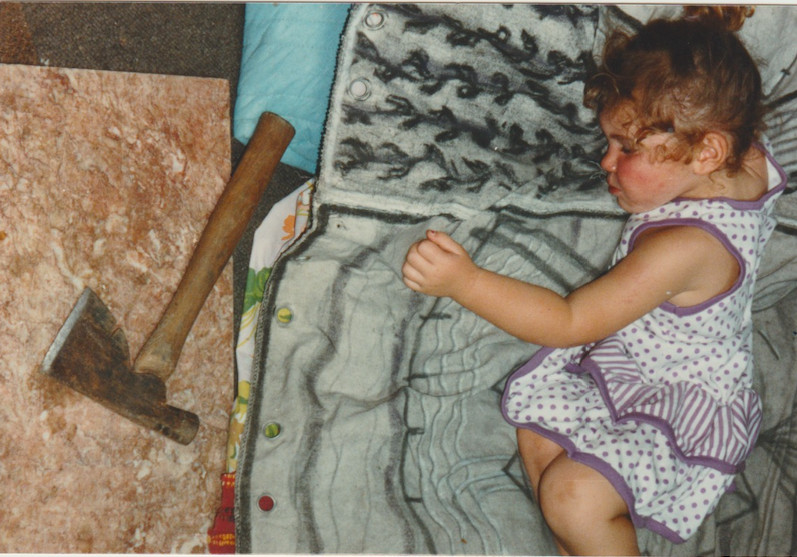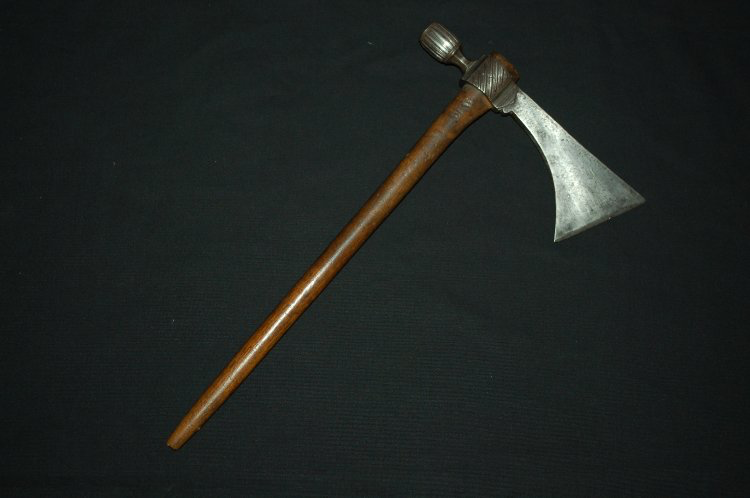Tomahawk

(Gabriele’s journal – May 8, 1992)

(Nick’s narrative – June 2, 2022)
Tito had gifted me a small hatchet from one of his thefts. Not that useful as a tool, but I found it evocative, and immediately began transforming it. I carved a turtle ideogram and other markings into its wooden handle. I sharpened the blade and practiced throwing it at the tree stump we used as a stool next to the fire pit. This ritual eventually got me to where I could stick a throw from various short distances every time. Both an actual and a symbolic achievement, the hatchet took on the status of a talisman. I tied seven black crow feathers, threaded onto a piece of rawhide, to the handle. The hatchet was now my tong war axe. I named it “Temahikan,” the Lenape word for axe.
The drug sales meant that there was constant traffic day and night at the Hill. Coco’s hut was less than ten yards from the tipi, and although most transactions were quick and quiet, the steady stream of strangers was disruptive and unnerving, especially at night. I stuck the blade of Temahikan within quick reach in the earth beside our bed before going to sleep each night.
Only about five feet tall, with disheveled curly black hair, Coco resembled a fairytale witch in her hunched-over crippled walk. She was not a good witch, but not an evil one either, just another addict getting by. Selling drugs was the only path available to her.
One day, a tall Hispanic guy I’d never seen before walked up to her hut. I was standing nearby and watched the argument unfold.
“The money’s good. Come on, take it.” In his hand he had a single bill.
“I can’t sell you anything. Get out of here. You shouldn’t even be here.”
“Come on, Coco. I’ve helped you out many times.”
“Don’t be stupid. You’re stupid for just being here.”
“I know. Just this one time.”
Coco refused the trade. “Get out of here and don’t come back. I won’t say nothing, but they’ll know you been here. I’m not gonna get hurt because of you.”
He started to leave but stopped and turned slowly to face me. It was then I saw it. The “crack smile.” Same as the one I’d seen on Blade, but healed over into an ugly ear-to-ear white scar.
I was on edge watching him walk up to me, the neck scar had flipped my mind into battle mode. It was as if I was back in jail. Was I the Wolf or the Lamb? Such a mindset is helpful and even necessary in jail, but can get you killed in the streets with its guns, knives, and other weapons. My adrenaline was pumping, and my entire being was ready for the confrontation with this wolf at the door.
“You’re in the tipi, right?” I faintly nodded yes. “I’ve never seen a real one before. That’s really something.”
His casual, friendly demeanor half disarmed me, but he still spelled danger.
“Where do you buy something like that?”
“My wife and I built it. She sewed together mailbags for the cover.”
I was wary, but decided to treat the stranger like any other citizen who innocently asked about the tipi. Also, I was curious about the story behind his crack smile. Was his story as horrifying as Blade’s had been?
“I’ll show you the inside if you want.”
“Yeah, okay, thanks.” He shoved the drugs he had bought from Coco under his belt as we walked around to the front of the tipi. I pulled back the door flap and offered him to step in, following behind him. We stood next to each other as he examined everything in detail.
“That’s something. You got a fire and everything. Who’s all these paintings of?”
“The people who live up here. My wife did their portraits.”
He pointed at one of the portraits. “Hey, that’s Red, right?” I smiled and nodded. “He’s an old partner of mine.”
He pointed to the bedding against the north wall of the tipi. “Is that where you sleep?”
“Yeah.” A wave of fear hit me as I answered the question. I felt momentarily stupid showing this possibly dangerous man the inside of my home. Then I reminded myself that dozens of people had been inside the tipi before him.
“What’s that, an Indian tomahawk?” I religiously displayed Temahikan each morning before I left, placing it on top of the white pillows of the bedding.
“No, it’s just an axe. I decorated it. Here, I’ll show you something. Stand next to me.” I picked up Temahikan, untying the crow feathers, and then tying them to my belt buckle. I stood a body’s length away from the tree stump stool. I raised the hatchet deliberately over my right shoulder, holding it there for a moment before uttering the four syllables under my breath and throwing it. “Ta-ma-hee-kan.” The sharpened blade of my war axe stuck into the side of the stump.

Visit this page to engage with Nick about hybrid literary genres crossing the fiction/nonfiction border. This inquiry is being written, and should ideally be read, contemporaneously with the excerpts. For the section that is current to this post, use this bookmark link